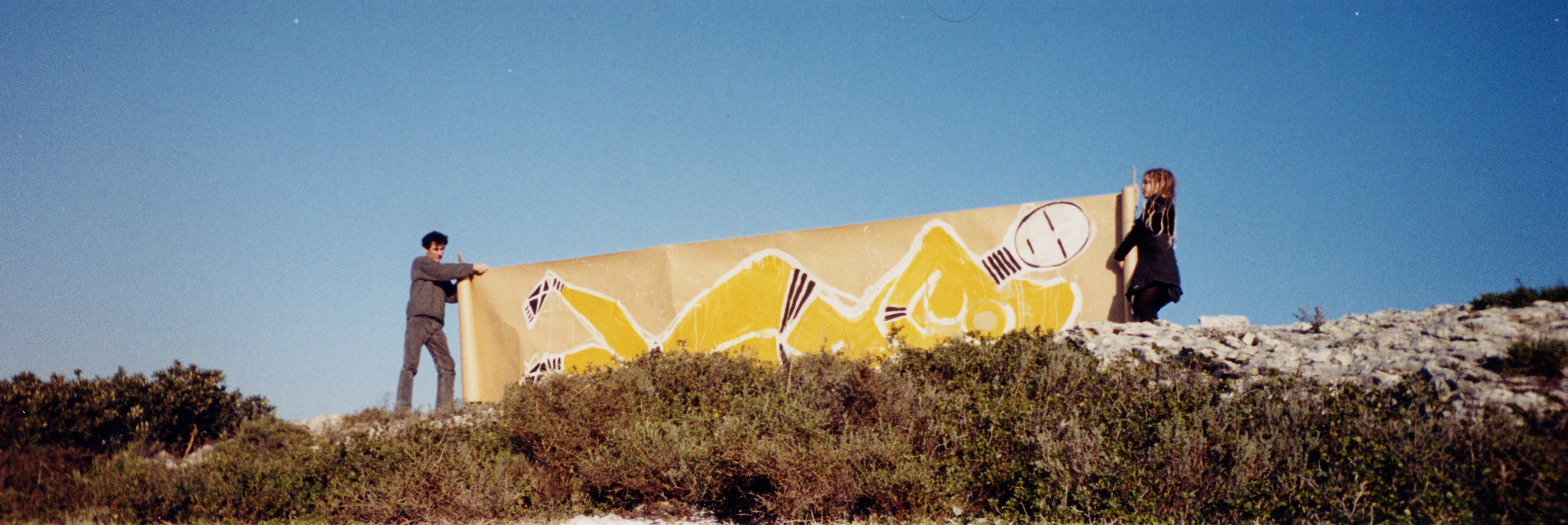

Stéphane Legendre CNRS | ENS
 |
CNRS - UMR 8197 Ecole Normale Supérieure 46 rue d'Ulm 75230 Paris Cedex 05 France Tel: +33.1.44.32.37.01 legendre@ens.fr |
Research team
Team
of Mathematical Eco-Evolution
Research
interests
My
work is at the interface of mathematics, computer science and ecology,
i.e., ecological modelling.
Development of the ULM computer program (Legendre & Clobert 1995, Ferrière & al 1996; Fig.1), widely used by ecologists.
- The ULM program can be downloaded there.
Figure 1. Chaotic
attractor in population dynamics studied with the ULM software (model
from Ferrière 1992).
Small populations dynamics:
- reintroductions (Sarrazin & Legendre 2000)
- extinctions (Legendre & al. 1999,
Schoener & al 2003, Legendre & al 2008)
Figure 2. Probability
of extinction as a function of time for the spider Argiope argentata
in
the Bahamas: observed (initial population size = 21-50
individuals; solid squares), and simulated (initial population size =
32 individuals; open squares). ULM model incorporating demographic stochasticity,
population ceiling and
environmental stochasticity (Schoener & al. 2003).
Impact of sexual selection on small populations:
- 2-sex demographic models (Legendre & al 1999, Legendre 2004, Bessa-Gomes & al 2004, 2010),
- The pair formation process (Bessa-Gomes & al 2003)
- Combinatorics (Møller & Legendre 2001; Fig. 3)
- Adaptive dynamics (Morlon &
Legendre 2002)
Figure 3.
The probability of one individual being mated as a function of
population size with monogamous pair formation, sex ratio 0.5, and
chance realization in the number of males and females (circles). When
each individual chooses its mate with probability 0.5, the probability
of being mated is reduced at low population sizes (squares), as
observed in captive populations (Møller &
Legendre 2001).
The ZEN computer program (Fig. 4) allows to study ecological models in an evolutionary perspective. The project was funded by an Action Incitative Bioinformatique from the CNRS.
- The ZEN program can be downloaded there
Figure 4. Adaptive radiation in bacteria with environmental catastrophes (mixing). Time on the horizontal axis, position on the vertical axis. The figure shows the positions of diversifying phenotypes adapted to different niches along a vertical gradient (ZEN simulation; collaboration with Andy Gonzalez, Régis Ferrière and Nirmala Massin).
Figure 5. Evolutionary restoration after environmental change. Distribution of phenotypes along time in polymorphic populations. The environment is constant over the first 21000 generations and changes gradually between time 21000 and 22000. Only 2 branches persist. The environment is progessively restored to its initial state from time 31000 to 32000. Diversity recovers. Model of cooperative evolution (Ferriere & Legendre 2013).
Allometry
Evolutionary entropy is a measure of the
life-cycle complexity introduced by L. Demetrius. We show that entropy
is in logarithmic relation with generation
time (Fig. 6), and with body
size. When
entropy is considered as a measure of fitness, this implies that along
evolutionary time, body size should increase in equilibirum species
(Cope's rule), and decrease in opportunistic species (Demetrius,
Legendre & Harremöes 2009).
Figure 6. The relation S ~ log T + b for 127 species of mammals, with S evolutionary entropy and T generation time (Demetrius & al. 2009). The large dot corresponds to Homo sapiens.
Trophic networks (food webs; Lazzaro & al 2009, Gauzens & al 2013, Gauzens & al 2015)
The n_w program (Fig. 7), can be downloaded there.
Bipartite ecological networks (plant-pollinator, site-species, host-parasite, male-female, ...)
The a2b program can be downloaded there.
Publications
- Legendre
S & J Clobert. 1995. ULM, a software for conservation and
evolutionary biologists. Journal of Applied Statistics 22:817–834.
- Thomas-Orillard
M & S Legendre. 1996. Virus C de la Drosophile et dynamique
d'une
population hôte. Comptes Rendus de l'Académie des
Sciences de Paris
319:615–621. PDF
file
- Ferrière
R, F Sarrazin, S Legendre & J-P Baron. 1996. Matrix population
models applied to viability analysis and conservation: Theory and
practice with ULM software. Acta Oecologica 17:629–656.
- Legendre
S, J Clobert, AP Møller & G Sorci. 1999. Demographic
stochasticity
and social mating system in the process of extinction of small
populations: The case of passerines introduced to New Zealand. American
Naturalist 153:449–463. PDF
file
- Sarrazin
F & S Legendre. 2000. Demographic approach to releasing adults
versus young in reintroductions. Conservation Biology 14:488-500. PDF
file
- Barot
S, J Gignoux, R Vuattoux & S Legendre. 2000. Demography of a
savanna palm tree in Ivory Coast (Lamto): population persistence and
life-history. Journal of Tropical Ecology 16:637–655.
PDF
file
- Møller
AP & S Legendre. 2001. Allee effect, sexual selection and
demographic stochasticity. Oikos 92:27–34. PDF
file
- Barot S,
J Gignoux & S Legendre. 2002. Stage-classified matrix models
and age estimations. Oikos 96:56–61. PDF
file
- Morlon
H & S Legendre. 2002. A model of sexual selection using
adaptive
dynamics: The Fisher's runaway and its reversibility. Unpublished
manuscript. PDF
file
- Schoener
TW, J Clobert, S Legendre & DA Spiller. 2003. Life-history
models
of extinction: A test with island spiders. American Naturalist
162:558–573. PDF
file
- Bessa-Gomes
C, S Legendre, J Clobert & AP Møller. 2003. Modeling
mating
patterns given mutual mate choice: The importance of individual mating
preferences and mating system. Journal of Biological Systems
11(3):205–219. PDF
file
- Bessa-Gomes
C, M Danek-Gontard, P Cassey, AP Møller, S Legendre
& J Clobert.
2003. Mating behaviour influences extinction risk: insights from
demographic modelling and comparative analysis of avian extinction
risk. Annales Zoologici Fennici 40(2):231–245. PDF
file
- Chapron
G, P-Y Quenette, S Legendre & J Clobert. 2003. Evaluating
conservation strategies for the French Pyrenean brown bear (Ursus
arctos) population by using stage-structured population models. Comptes
Rendus Biologies 326:S174–S182. PDF
file
- Chapron
G; S Legendre, R Ferrière, J Clobert & RG Haight.
2003.
Conservation and control strategies for the wolf (Canis lupus) in
western Europe based on demographic models. Comptes Rendus Biologies
326:575–587. PDF
file
- Robert
A, F Sarrazin, D Couvet & S Legendre. 2004. Releasing adults
versus
young in reintroductions: Interactions between demography and genetics.
Conservation Biology 18:1–10. PDF
file
- Bessa-Gomes
C, S Legendre & J Clobert. 2004. Allee effects, mating systems
and
the extinction risk in populations with two sexes. Ecology Letters
7:802–812.
PDF
file
- Legendre
S. 2004. Influence of age structure and mating system on population
viability. In
Evolutionary Conservation Biology (Ferrière R,
U
Dieckmann & D Couvet eds.), Cambridge University Press, pp.
41–58. PDF
file
- Chapron G, DG Miquelle, JG Goodrich, A Lambert, S Legendre & J Clobert. 2005. The effect of poaching on tigers in the russian far east. In Tigers of Sikhote-Alin Zapovednik: ecology and conservation, DG Miquelle, JG Goodrich & EN Smirnov (eds.), pp. 191–195, chapter 25 (in Russian). PDF file
- Legendre S. 2008. La séparation en biologie. In De la Séparation, directed by C Schaeffer, L'Harmattan, Paris, pp. 55–71. PDF file
- Legendre S, TW Schoener, J Clobert & DA Spiller. 2008. How is extinction risk related to population-size variability over time? A family of models for species with repeated extinction and immigration. American Naturalist 172:282–298. PDF file
- Chapron G, DG Miquelle, A Lambert, JM Goodrich, S Legendre & J Clobert. 2008. The impact on tigers of poaching versus prey depletion. Journal of Applied Ecology 45:1667–1674. PDF file
- Demetrius L, S Legendre & P Harremöes. 2009. Evolutionary entropy: A predictor of body size, metabolic rate and maximal life span. Bulletin of Mathematical Biology 71:800–818. PDF file
- Lazzaro X, G Lacroix, B Gauzens, J Gignoux & S Legendre. 2009. Predator foraging behaviour drives food-web topological structure. Journal of Animal Ecology 78:1307–1317. PDF file
- Legendre S. 2009. The number of crossings in a regular drawing of the complete bipartite graph. Journal of Integer Sequences, Vol. 12, article 09.5.5
- Bessa-Gomes
C, S
Legendre & J Clobert. 2010. Discrete two-sex models of
population dynamics:
On modelling the mating function. Acta Oecologica 36:439–445. PDF
file
- Legendre S. 2011. La résilience des écosystèmes. In De la Réparation, directed by C Schaeffer, L'Harmattan, Paris, pp. 41–51. PDF file
- Legendre S & P Paclet. 2011. On the permutations generated by cyclic shift. Journal of Integer Sequences, Vol. 14, article 11.3.2.
- Hulot F, D Carmignac, S Legendre, C Yéprémian & C Bernard. 2012. Effects of microsystin-producing and microsystin-free strains of Planktothrix agardhii on long-term population dynamics of Daphnia magna. Annales de Limnologie - International Journal of Limnology 48:337–347. PDF file
- Demetrius L & S Legendre. 2013. Evolutionary entropy predicts the outcome of selection: Competition for resources that vary in abundance and diversity. Theoretical Population Biology 83:39–54. PDF file
- Ferriere R & S Legendre. 2013. Eco-evolutionary feedbacks, adaptive dynamics and evolutionary rescue theory. Philosophical Transaction of the Royal Society B 368 20120081. PDF file
- Chaine A, S Legendre & J Clobert. 2013. The co-evolution of multiply-informed dispersal: Information transfer across landscapes from neighbors and immigrants. PeerJ 1:e44; DOI 10.7717/peerj.44. PDF file
- Gauzens B, S Legendre, X Lazzaro & G Lacroix. 2013. Food-web aggregation, methodological and functional issues. Oikos 122:1606–1615. PDF file
- Mugabo M, S Perret, S Legendre & J-F Le Galliard. 2013. Density-dependent life history and the dynamics of small populations. Journal of Animal Ecology 82:1227–1239. PDF file
- Edeline
E, G Lacroix, C Delire, N Poulet & S Legendre.
2013. Ecological emergence of thermal clines in body size.
Global
Change Biology 19:3062–3068. PDF
file. Supplementary information PDF
file
- Bienvenu F, L Demetrius & S Legendre. 2013. A general formula for the generation time. arXiv.q-bio.PE
- Legendre S. 2014. Foldings and meanders. Australasian Journal of Combinatorics 58: 275–291.
- Legendre S. 2015. Labeled Fibonacci trees. The Fibonacci Quarterly 53: 152–167. arXiv.maths.NT
- Bienvenu F & S Legendre. 2015. A new approach to the generation time in matrix population models. The American Naturalist 185: 834–843. PDF file - Appendix PDF file
- Gauzens B, E Thébault, G Lacroix, & S Legendre. 2015. Trophic groups and modules: two levels of group detection in food webs. Journal of the Royal Society Interface 12, 20141176. PDF file - Supp1 PDF file - Supp2 PDF file
- Gauzens B, S Legendre, X Lazzaro & G Lacroix. 2016. Intermediate predation pressure leads to maximal complexity in food webs. Oikos 125: 595-603. PDF file
- Brom T, M Massot, S Legendre & D Laloi. 2016. Kin competition drives the evolution of sex-biased dispersal under monoandry and polygyny, not under monogamy. Animal Behavior 113: 157–166. PDF file
- Bienvenu F, E Akçay, S Legendre & D McCandlish. 2017. The genealogical decomposition of a matrix population model with application to the aggregation of stages. Theoretical Population Biology 115: 69–180. PDF file
- Massot M, S legendre, P Fédérici & J Clobert. 2017. Climate warming: a loss of variation in populations can accompany reproductive shifts . Ecology Letters 20:1140–1147. PDF file - Supp PDF file
- Ramirez P & S Legendre. 2017. Revisiting asymmetric marriage rules. Social Networks. PDF file








